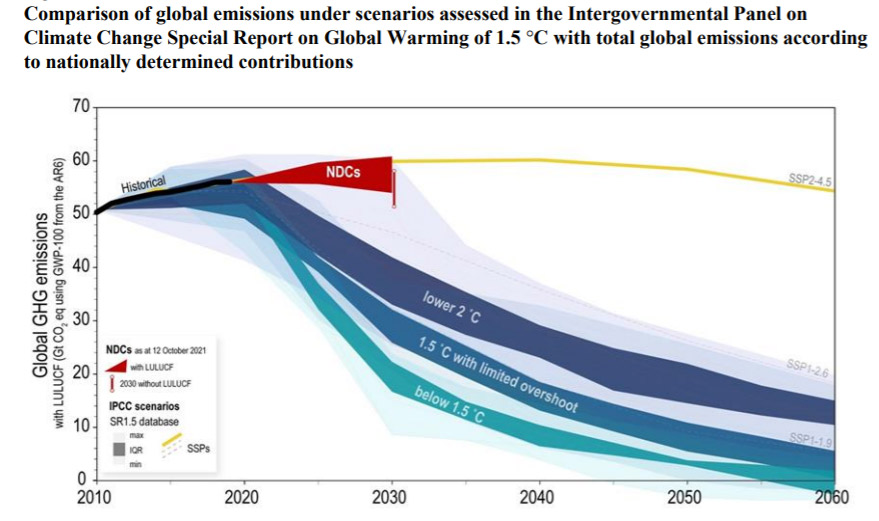The world is “way off track” from achieving the emissions cuts needed to limit global warming to safer levels, according to the latest data from the World Meteorological Organisation.
Over the last twelve months, global greenhouse gas emissions surged to a new record high, despite the impacts of the Covid-19 pandemic, and 2021 is set to continue that trend.
The bleak assessment came as a new report identified Australia as both a laggard and one the world’s highest per capita emitters, with little in the way of detailed policy commitments despite the opportunities and the risks from a lack of action.
On Tuesday, the World Meteorological Organisation released its latest Greenhouse Gas Bulletin – less than a week before world leaders converge on Glasgow for the next round of international climate negotiations – and the message is bleak.
The global increase in atmospheric carbon dioxide concentrations was largely uninterrupted by the Covid-19 pandemic, surging to a new high of 413.2 parts per million in 2020, and the pace of increase was in line with an average annual increase of 2.4 parts per million observed over the last decade.
Concentrations of other greenhouse gases, including methane and nitrous oxide, were also observed to increase to new record levels.
The WMO found that global greenhouse gas emissions from fossil fuel use fell by just 5.6 per cent in 2020, with the drop caused primarily by Covid-19 related restrictions.
It shows that even an event as disruptive as the global pandemic led to only a minor and temporary impact on emissions.
As part of its annual assessment, the WMO collates emissions data from a range of observatories, including Mauna Loa in Hawaii, and Cape Grim in Tasmania.
The WMO estimates that between 1990 and 2020, radiative forcing, the warming effect that elevated levels of greenhouse gases have on the Earth’s temperatures, increased by 47 per cent. Carbon dioxide was responsible for around four-fifths of that increase, with much of the remaining warming attributed to methane.

WMO Secretary-General professor Petteri Taalas, said the latest data showed the world was “way off track” when it came to reducing greenhouse gas emissions at a rate consistent with avoiding unsafe levels of global warming.
“The Greenhouse Gas Bulletin contains a stark, scientific message for climate change negotiators at COP26,” he said.
“At the current rate of increase in greenhouse gas concentrations, we will see a temperature increase by the end of this century far in excess of the Paris Agreement targets of 1.5 to 2 degrees Celsius above pre-industrial levels.
“The amount of CO2 in the atmosphere breached the milestone of 400 parts per million in 2015. And just five years later, it exceeded 413 ppm.
“This is more than just a chemical formula and figures on a graph. It has major negative repercussions for our daily lives and well-being, for the state of our planet and for the future of our children and grandchildren.”
“Carbon dioxide remains in the atmosphere for centuries and in the ocean for even longer.
The last time the Earth experienced a comparable concentration of CO2 was 3-5 million years ago, when the temperature was 2-3°C warmer and sea level was 10-20 meters higher than now. But there weren’t 7.8 billion people then,” Taalas added.
Taalas called on countries, ahead of the COP26 talks, to increase their commitments to reduce greenhouse gas emissions.
“Many countries are now setting carbon neutral targets and it is hoped that COP26 will see a dramatic increase in commitments,” Taalas said.
“We need to transform our commitment into action that will have an impact of the gases that drive climate change. We need to revisit our industrial, energy and transport systems and whole way of life. The needed changes are economically affordable and technically possible. There is no time to lose.”
A new assessment launched by Climate Resource found that national pledges to reduce emissions, known as Nationally Determined Contributions (NDCs) under the Paris Agreement, needed to be much stronger.
“Even though we have seen significant progress in closing the gap in the latest NDCs there is still a long way to go and an urgent need to increase the pace of transition towards a zero-emissions world”, Climate Resource’s Malte Meinshausen said.
The group said that countries like Australia had a duty to show leadership in reducing emissions, which would also allow them to seize upon new economic opportunities.
“Australia has the highest per-capita emissions in the developed world, is at the bottom of the international rankings on emissions reductions and is missing enormous opportunities,” co-director Dr Zebedee Nicholls said.
“Australia has great resources: a world-class solar industry, world class climate scientists, and treasures worth protecting like the great barrier reef.”
“Yet, for some reason we are one of the last countries to the table. A strong 2030 emission reduction target, around 50%, is what the world is waiting for in Glasgow,” Nicholls added.








